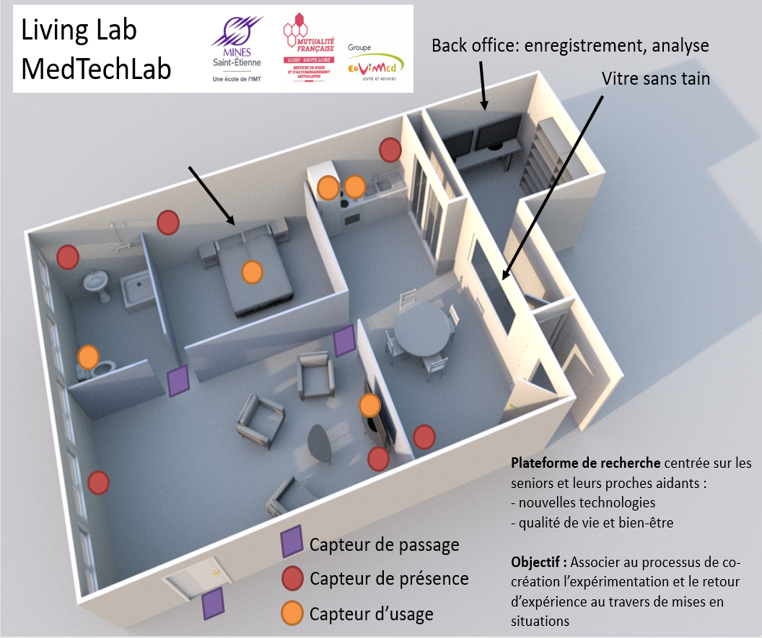In the midst of a crisis, hospitals are using digital simulation to organize care
Thierry Garaix and Raksmey Phan are systems engineering researchers at Mines Saint-Étienne[1]. In response to the current health crisis, they are making digital simulation and digital twins available to health services to inform their decision-making. This assistance is crucial to handling the influx of patients in hospitals and managing the post-peak period of the epidemic.
The organization of the various departments within a hospital is a particular concern in the management of this crisis. Based on the number of incoming patients and how many of them require special care, certain departments must be turned into dedicated wards for Covid-19 patients. Hospitals must therefore decide which departments they can afford to close in order to allocate beds and resources for new patients. “We’re working on models to simulate hospitalizations and intensive care units,” says Thierry Garaix, a researcher in healthcare systems engineering at Mines Saint-Étienne.
“Cardiac surgery operating rooms are already equipped with certain resources needed for Covid wards, such as respirators,” explains the researcher. This makes them good candidates for receiving Covid patients in respiratory distress. These simulations give caregivers a clearer view in order to anticipate the need for hospital and intensive care beds. “At the peak of the epidemic, all possible resources are reassigned,” he explains. “Once the peak has passed, the number of cases admitted to the hospital begins to drop, and the hospital must determine how to reallocate resources to the usual activities.”
Visualizing the hospital
It is essential for hospitals to have a good understanding of how the epidemic is evolving in order to define their priorities and identify possibilities. Once the peak has passed, fewer new patients are admitted to the hospital every day but those that remain still require care. These simulations make it possible to anticipate how long these departments will remain occupied by Covid patients and estimate when they will be available again.
“The tool I’m developing makes it possible to visualize how the flow of Covid patients will progress over time to help the university hospital make decisions,” says Thierry Garaix. The researcher provides the model with data about the length of hospital stays, time spent in the hospital or intensive care unit and the capacity of each hospital unit. The model can then digitally simulate patient pathways and visualize flows throughout the hospital. “It’s important to understand that the progression isn’t necessarily linear,” he adds, emphasizing that “if we see a drop in the number of cases, we have to consider the possibility that there could then be a rise in the epidemic.”
But even if a hospital unit could be freed up and reallocated to its regular activities, it may be more cautious to keep it available to handle new cases. “At the beginning of the epidemic, health services had to rush to allocate resources and set up Covid units quickly,” says Thierry Garaix. “The benefit of these simulations is that they make it easier to anticipate the management of resources, so that resources can be allocated gradually depending on how the epidemic evolves.”
“Strictly speaking, it is not a digital twin since the model does not directly interact with reality,” says the researcher. “But if a digital twin of all of the hospital’s departments had been available, it would have been of great help in planning how resources should be allocated at the beginning of the epidemic.”
Visualizing people
A digital twin could help assess a number of complex aspects, including the effects of isolation on the health of elderly people. “It’s a project we’ve been working on for a while, but it has taken on new importance in light of the lockdown measures,” says Raksmey Phan, who is also a healthcare systems researcher at Mines Saint-Étienne. The AGGIR scale is generally used to measure an individual’s loss of autonomy. It breaks health status into different categories ̶̶ autonomous, at risk, fragile, dependent ̶̶ in order to propose appropriate care. The digital twin would be used to anticipate changes in health status, identify at-risk individuals and prevent them from moving towards a situation of dependence.
“It’s important to point out that a fragile individual can, with appropriate physical activity, return to a category corresponding to a better health status. However, once an individual enters into a situation of dependence, there’s no going back,” explains Raksmey Phan. The aim of this new digital twin project is to predict this progression in order to propose appropriate activities before it is too late. At present, the lack of physical activity as a result of the lockdown raises the risk of adverse health outcomes since it implies a loss of mobility.
In the context of lockdown, this digital twin therefore makes it possible to estimate the impact of lack of physical activity for elderly people. Before the lockdown period, researchers installed sensors in homes of volunteers, on doors, objects such as refrigerators, front doors etc. to evaluate their presence and level of activity at home. “With fairly simple sensors, we have a model that is well-aligned with reality and is effective for measuring changes in an individual’s health status,” he adds.
These sensors evaluate the time spent in bed, on the couch, or indicate if, on the other hand, individuals spend a lot of time standing up, moving around, or if he leaves the house often. With this data, the digital twin can extrapolate new data about a future situation, and therefore predict how an individual’s health status will progress over time. “The goal is essentially to analyze troubling changes that may lead to a risk of fragility, and react in order to prevent this from occurring,” explains the researcher.
The researchers, who are working with the insurance company EOVI MCD, could then propose appropriate activities to maintain good health. Even in the midst of a pandemic, and taking social distancing measures and an effort to limit contact into account, it is possible to propose activities to be done at home, in front of the TV for example. “The insurance provider could propose activities and home services or potentially direct them to a retirement home,” says Thierry Garaix. “The key focus is providing an opportunity to act before it’s too late by estimating the future health status of the individuals concerned, and reacting by proposing appropriate structures or facilities,” say the two researchers.
[1] Thierry Garaix and Raksmey Phan are researchers at the Laboratory of Informatics, Modeling and Optimization of Systems (LIMOS), a joint research unit between Mines Saint-Étienne/CNRS/University of Clermont-Auvergne.
Tiphaine Claveau





Leave a Reply
Want to join the discussion?Feel free to contribute!